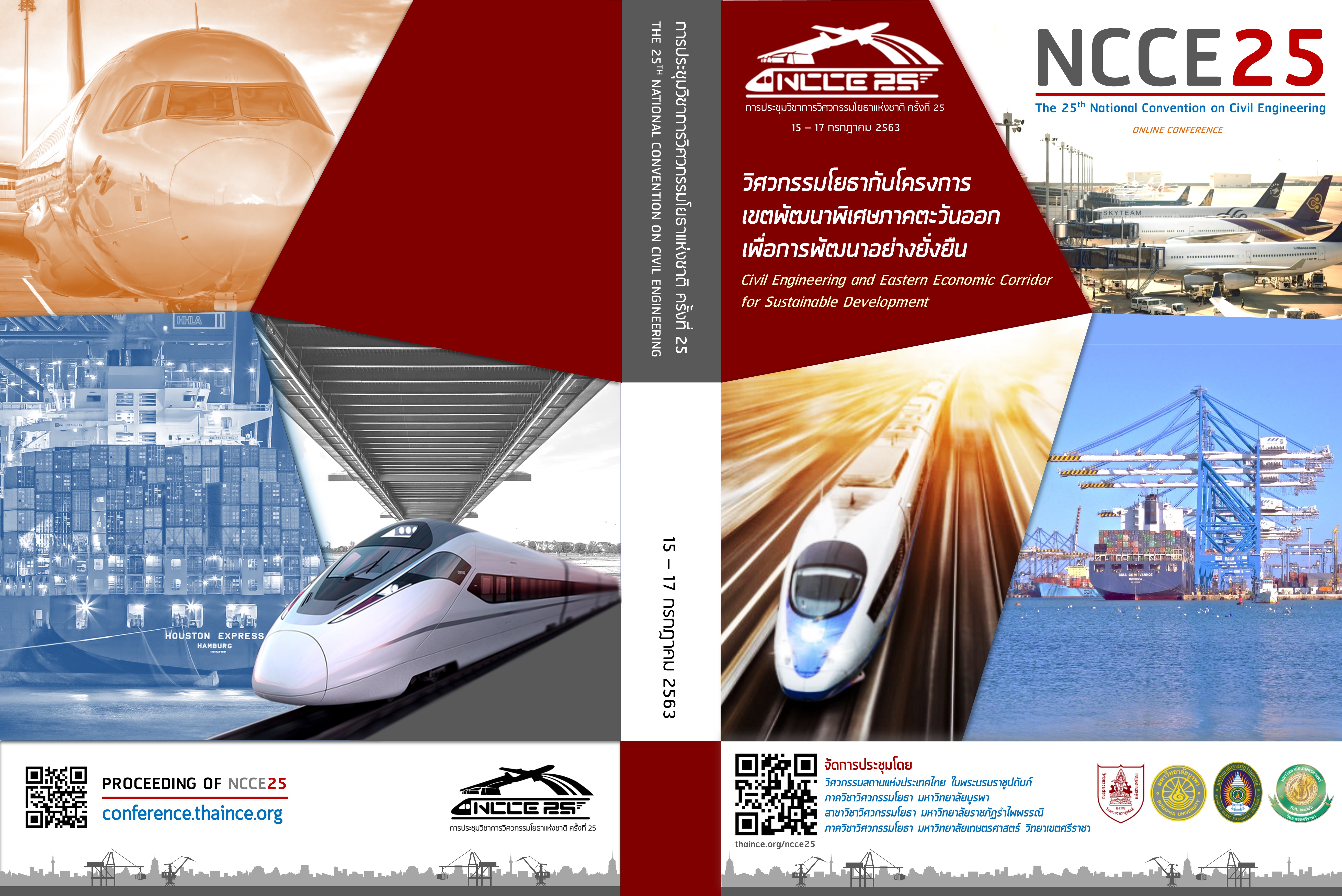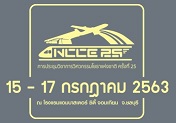การสำรวจอัตราการเกิดคาร์บอเนชันของโครงสร้างสะพานลอยคนเดินข้ามในเขตชุมชนจังหวัดชลบุรี
คำสำคัญ:
โครงสร้างสะพานลอยคนเดินข้าม, คาร์บอนไดออกไซด์, คาร์บอเนชัน, การทำนายอายุปลอดการซ่อมแซม, จังหวัดชลบุรีบทคัดย่อ
การศึกษานี้เป็นการตรวจสอบการเกิดคาร์บอเนชันของโครงสร้างสะพานลอยคนเดินข้ามในเขตชุมชนจังหวัดชลบุรี โดยทำการวัดความเข้มข้นก๊าซคาร์บอนไดออกไซด์และความชื้นสัมพัทธ์ของสิ่งแวดล้อม วัดระยะคอนกรีตหุ้มเหล็กเสริมและประเมินกำลังอัดประลัย พร้อมเจาะเก็บชิ้นตัวอย่างคอนกรีตเพื่อทดสอบความลึกคาร์บอเนชันของของโครงสร้างสะพานลอยคนเดินข้ามที่ตั้งอยู่ในเขตชุมชนของจังหวัดชลบุรี โดยเลือกใช้โครงสร้างสะพานลอยคนเดินข้าม 4 สะพาน ข้อมูลที่ได้นำมาหาการเกิดคาร์บอเนชันและทำนายอายุของโครงสร้างสะพานลอยคนเดินข้าม โดยใช้สมการของ Fick's first law of diffusion และมาตรฐานการออกแบบความคงทนสำหรับโครงสร้างที่เผชิญคาร์บอเนชันของกรมโยธาธิการและผังเมือง (มยผ.) ผลการศึกษาพบว่า ระยะคอนกรีตหุ้มเหล็กเสริมของโครงสร้างสะพานลอยคนเดินข้ามที่ตั้งอยู่ในเขตชุมชนของจังหวัดชลบุรี มีค่าเฉลี่ยระหว่าง 31 ถึง 44 มิลลิเมตร และกำลังอัดประลัยของคอนกรีตมีค่าเฉลี่ยระหว่าง 307 ถึง 367 กิโลกรัมต่อตารางเซนติเมตร และความลึกคาร์บอเนชันมีค่าเฉลี่ยอยู่ระหว่าง 32 ถึง 41 มิลลิเมตร ส่วนสัมประสิทธิ์ความลึกคาร์บอเนชันมีค่าเฉลี่ยอยู่ระหว่าง 6.4 ถึง 7.1 มิลลิเมตร/ปี1/2 สุดท้ายด้วยวิธีการตามสมการ Fick's first law of diffusion และมาตรฐาน มยผ. สามารถทำนายและคำนวณอายุปลอดการซ่อมแซมของโครงสร้างสะพานลอยคนเดินข้ามที่ตั้งอยู่ในเขตชุมชนของจังหวัดชลบุรีที่สัมผัสกับก๊าซคาร์บอนไดออกไซด์ได้ โดยผลที่ได้สามารถนำไปใช้ในการออกแบบวางแผนดูแลบำรุงรักษาโครงสร้างสะพานลอยคนเดินข้ามที่ต้องเผชิญกับสภาวะแวดล้อมคาร์บอเนชัน ตลอดจนป้องกันความเสียหายที่จะเกิดขึ้นในอนาคตได้
Downloads
เอกสารอ้างอิง
[2] P. Castro, E.I. Morenob and J. Genesca, (2000). Influence of marine micro-climates on carbonation of reinforced concrete buildings, Cement and Concrete Research, Vol 30, pp. 1565- 1571.
[3] J.Khunthongkeaw, S.Tangtermsirikul and T.Leelawat, (2006). A study on carbonation depth prediction for fly ash concrete, Construction and Building Materials, Vol.20, pp. 744-753.
[4] มาตรฐาน มยผ. 1501-51 ถึง มยผ. 1507–51, มาตรฐานการตรวจสอบโครงสร้างคอนกรีตเสริมเหล็กด้วยวิธีการทดสอบแบบไม่ทำลาย, กรมโยธาธิการและผังเมือง.
[5] มาตรฐาน มยผ. 1332 – 55, มาตรฐานงานคอนกรีตเมื่อพิจารณาความคงทนและอายุการใช้งาน, กรมโยธาธิการและผังเมือง.
ดาวน์โหลด
เผยแพร่แล้ว
วิธีการอ้างอิง
ฉบับ
บท
การอนุญาต
บทความทั้งหมดที่ได้รับการคัดเลือกให้นำเสนอผลงานในการประชุมวิชาการวิศวกรรมโยธาแห่งชาติ ครั้งที่ 25 นี้ เป็นลิขสิทธิ์ของ วิศวกรรมสถานแห่งประเทศไทย ในพระบรมราชูปถัมภ์



